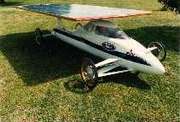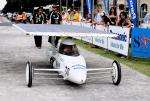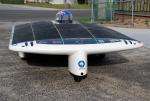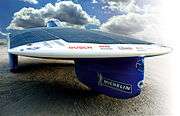Aurora Solar Car
The Aurora Vehicle Association is a group of volunteers who are dedicated to achieving and demonstrating extreme efficiency in transport. Aurora was started in 1980 by building high-fuel-efficiency petrol-powered vehicles. Between 1983 and 1985 Aurora held the world record for fuel economy at 1808 km per litre (5107 miles per imperial gallon). In 1987, when Hans Tholstrup devised the first trans-Australian World Solar Challenge, Aurora turned to solar car development and has been a contestant in every World Solar Challenge and has achieved 1 win, 4 second places, 1 third place, 1 fifth place, 1 sixth place and 1 crash.
| Incorporated | |
| Industry | Solar Cars |
| Founded | 1980 |
| Headquarters | Melbourne, Victoria, Australia |
Key people | Andris Samsons(Chairman) |
| Website | Aurora Solar Car Website |
Aurora is a non-profit group which is sustained by corporate sponsorship from companies such as CSIRO, Mazda and Sumitomo (amongst many others).
At various points in its history, Aurora has also been associated with some of Australia's leading universities such as UNSW, University of Technology, Sydney, University of Melbourne and RMIT.
Cars
Aurora have constructed several solar-powered cars and are now in their 4th generation of car designs.
Ford Model "S" - 1987
| Specifications | |
| Overall length | 5.5 meters |
| Overall width | 2.0 meters |
| Weight | 250 kg |
| Top speed | 100 km/h |
| Drag coefficient | 0.26 |
| Solar Panel | 1400 watts |
Christine - 1990
| Specifications | |
| Overall length | 3.1 meters |
| Overall width | 1.6 meters |
| Weight | 180 kg |
| Top speed | 112 km/h |
| Drag coefficient | Cd 0.27 |
| Solar Panel | 1100 watts |
Aurora Q1 - 1993
| Specifications | |
| Overall length | 4.41 meters |
| Overall width | 2.0 meters |
| Weight | 220 kg |
| Top speed | 112 km/h |
| Drag coefficient | Cd 0.095 with race array, 0.08 with prototype smooth array. |
| Solar Panel | 1300 watts |
Southern Aurora - 2000
| Specifications | |
| Overall length | 4.58 meters |
| Overall width | 2 meters |
| Weight | 215 kg |
| Top speed | 122 km/h |
| Drag coefficient | |
| Solar Panel | 1500 watts |
Aurora 101 - 1996
| Specifications | |
| Overall length | 4.1 meters |
| Overall width | 1.8 meters |
| Weight | 130 kg |
| Top speed | 152 km/h |
| Drag coefficient | Cd 0.08 |
| Solar Panel | 1250 watts |
The current flagship is known as Aurora Evolution (Previously Aurora 101). The car weighs 120 kg without batteries or a driver and has attained speeds of 155 km/h. It is built around a triangular carbon fibre frame (with a circular cross section) with a single driven front wheel and two rear wheels. The car's body is attached to the frame at three points through springs and shock absorbers.
The car is extremely aerodynamic, with a drag coefficient of 0.1 and a frontal area of 0.76 square metres. The motor, which was developed as a joint effort between CSIRO, the University of Technology, Sydney and Aurora, weighs 15 kg and has a continuous operating power of 1.8 kW.
The car's power comes from its solar array, which covers a majority of the upper half of its body. There is a total of 5.98 square metres of silicon solar cells, which originally provided up to 1250 W but now provides closer to 1200 W due to degradation. In full racing trim (as per the World Solar Challenge rules) the car weighs 240 kg with its batteries and driver.
Aurora 101 finished second in the 2003 WSC race[1]
Aurora 101 finished 3rd in the 2007 WSC race.[2]
- Fastest lap at Hidden Valley Racetrack, Darwin Average speed 91.83 km/h.
- Fastest lap at Suzuka Racetrack Average speed 93.08 km/h.
- Distance covered in 24 hours non-stop record 1590 km.
World Records
| Year | Record |
|---|---|
| 1983 | Shell Mileage Marathon. 2,948 mpg |
| 1984 | Shell Mileage Marathon. 3,133 mpg |
| 1985 | Shell Mileage Marathon. 5,107 mpg |
| 1994 | Trans-Continental Solar Challenge. Perth to Sydney, 4,000 km, 8.5 days |
| 1998 | Citipower SunRace. Adelaide to Sydney. 2,080 km. Average 100.9 km/h over 100 km |
| 2000 | Sydney to Melbourne Day Record: 877 km |
| 2002 | 13,054 km in 24 days - Long distance solar car journey. |
| 2002 | 780 km Longest day distance on solar energy |
| 2002 | 111.2 km/h Highest on-road average speed for 100 km |
| 2002 | 16,660 km (since 1993) Longest distance solar car driver |
| 2002 | 131.0 km/h for 100 miles (est. 1994 Biel 121.6 km/h) |
| 2002 | 131.5 km/h for One Hour (est. 1994 Biel 123.0 km/h) |
| 2002 | 132.1 km/h for 100 km (est. 1994 Biel 124.3 km/h) |
| 2002 | 86.2 km/h on solar energy alone (est. 1994 Biel 82.6 km/h) |
| 2004 | 1255 km in 24 hours |
| 2005 | 1701 km in 24 hours |
| 2007 | World record distance for a battery powered car, in 'Christine', 811 km at 53.05 km/hr |
Aurora in WSC
| Event Year | Placing | Average Speed | Qualification Grid Position |
|---|---|---|---|
| 1987 | 2nd Place | 44.48 km/h | 4 |
| 1990 | 6th Place, 1st in Class (Lead Acid) | 50.20 km/h | 13 |
| 1993 | 5th Place | 70.08 km/h | 17 |
| 1996 | Did not finish[3] | - | 9 |
| 1999 | 1st Place[4] | 72.96 km/h | 7 |
| 2001 | 2nd Place | 90.26 km/h | 5 |
| 2003 | 2nd Place | 91.90 km/h | 1 |
| 2005 | 2nd Place | 92.03 km/h | 1 |
| 2007 | 3rd Overall, 1st in Class | 85.00 km/h | 3 |
| 2009 | 6th Place | 70.82 km/h | 1 |
References
- http://news.bbc.co.uk/2/hi/science/nature/3203941.stm
- http://www.smh.com.au/news/environment/dutch-win-solar-car-race/2007/10/25/1192941227965.html,
- SAE Australasia, September / October 1999, Volume 59, Number 5, Page 15
- Australian Energy News, Issue 14, Dec 1999, Page 39




